Pelicans are large water birds known for their distinctive long bills and throat pouches. They have a wingspan of up to 9 feet, making them one of the largest flying birds in the world. Pelicans usually have white or light-colored feathers with black or dark brown accents on their wings and backs. They also have webbed feet that help them swim through water.
Their most notable feature is their bill, which can grow up to 18 inches long in some species. The bill has a hooked tip that helps pelicans catch fish by scooping them up from the water’s surface. The pelican’s throat pouch is another unique characteristic. It allows them to store fish while hunting, allowing them to capture larger prey than they would be able to swallow whole.
Pelicans are found all over the world, living near coastal areas or freshwater lakes and rivers. Despite being heavy birds due to their sizeable bills and bodies, pelicans are excellent flyers who soar effortlessly above the ocean waves, searching for food or gliding gracefully just above the treetops along riverbanks as they seek out sheltered spots for nesting purposes.
Overall, these fascinating creatures continue to captivate bird watchers worldwide thanks not only to their impressive physical attributes but also due largely in part because of how prevalent they remain across diverse environments globally today!
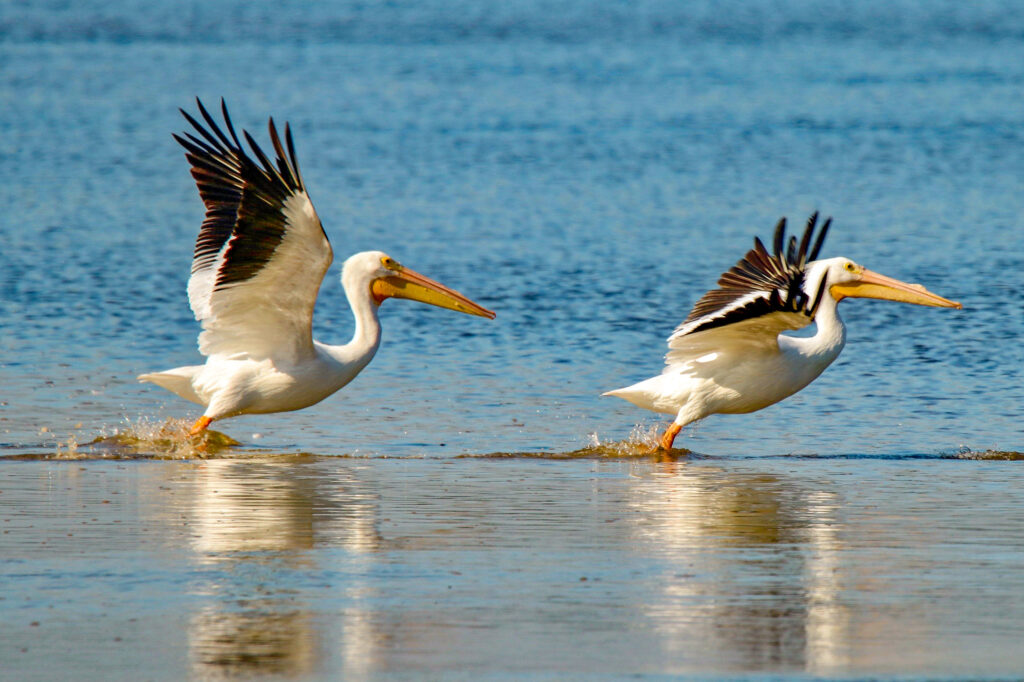
Pelicans are large water birds known for their distinctive long bills and throat pouches.
©Susan Rydberg/Shutterstock.com
A Group of Pelicans
One common name for a group of pelicans is a “pod.” This term is often used when referring to groups of smaller pelican species, such as the brown pelican or the Peruvian pelican.
Another name used for these groups is “scoop.” This term is thought to have originated from the way in which these birds scoop up fish from the water using their unique beak structure. It’s also worth noting that this term can sometimes be used interchangeably with “pod,” depending on regional dialects.
A “raft” or “squadron” of pelicans refers specifically to larger groups of these birds – usually, those seen congregating in coastal areas during migration periods. These terms convey a sense of movement and motion, highlighting how flocks of migrating pelicans can appear almost like ships sailing across the ocean.
Finally, some bird enthusiasts may use more poetic terms such as “flock” or a “rookery” when describing large groups of soaring pelicans gliding gracefully through the sky.
In some areas, a group of pelicans is called a “brief” or a “pouch.”
In summary, while there isn’t one definitive answer regarding what to call a group of pelicans, it’s clear that there are plenty of options out there!
Common names for a group of pelicans:
- Pod
- Scoop
- Raft
- Squadron
- Flock
- Rookery
- Pouch
- Brief
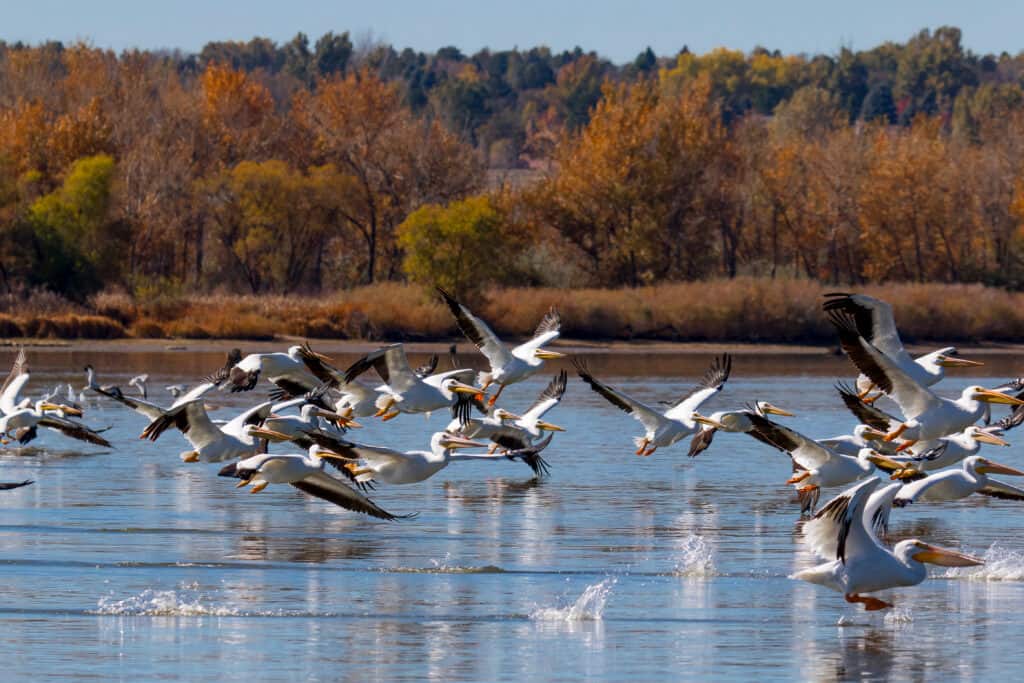
Larger groups of pelicans are often called a raft or squadron.
©Images by Dr. Alan Lipkin/Shutterstock.com
Group Behavior
Pelicans are social birds that exhibit a variety of interesting group behaviors. One of the most notable is their tendency to form large flocks while hunting for food in shallow waters. These groups can consist of dozens or even hundreds of pelicans, and they work together to corral fish into tight schools before scooping them up in their pouches.
During the breeding season, male pelicans will also engage in elaborate courtship displays with females. This often involves synchronized head-bobbing, bill-clapping, and preening rituals designed to impress potential mates.
When pelicans are searching for a partner, they come together in large groups to display their large bills. As part of the courtship process, they bow, strut, and take short flights in an effort to catch the attention of another.
Pelicans are social birds that prefer to nest in colonies or groups. These colonies can vary in size, ranging from just a few pairs of pelicans to hundreds or even thousands of individuals. Pelican colonies are typically located near bodies of water where they can find food, such as fish and crustaceans. Within the colony, individual pelicans may form smaller sub-groups based on things like age, sex, or mating status.
During nesting season, male and female pelicans work together to build their nests, incubate their eggs, and care for their young until they are old enough to leave the colony and fend for themselves. Overall, group behavior plays an important role in the survival and success of pelican populations around the world.
In addition to these cooperative behaviors, pelicans have also been observed engaging in aggressive interactions within their own groups. Dominant individuals may use physical posturing or vocalizations to assert their authority over others, while subordinates may avoid confrontation by moving away from the dominant bird.
Overall, the group behavior of pelicans is complex and multifaceted, reflecting both cooperation and competition among individuals within a larger social structure.
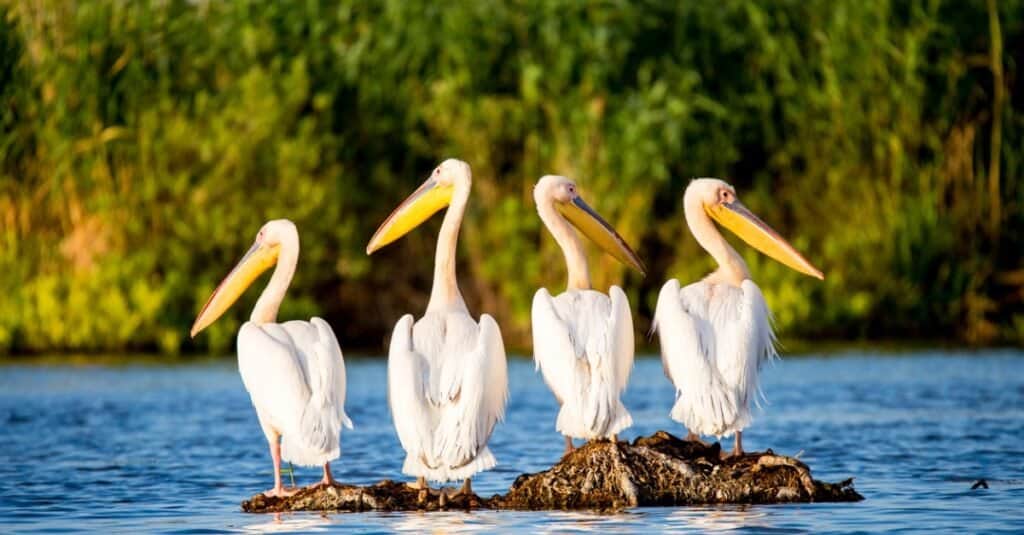
Pelican colonies can vary in size, ranging from just a few pairs of pelicans to hundreds or even thousands of individuals.
©iStock.com/CalinStan
Distribution and Habitat
Pelicans are large aquatic birds that are found all over the world, inhabiting both freshwater and saltwater environments. There are eight different species of pelican, each with its own unique range and distribution. You can see a pod of pelicans on every continent in the world except for Antarctica. They prefer warmer regions and extend their range considerably during the breeding season.
The Pelican Pouch
The pelican pouch, also known as the gular sac, is a distinctive feature of this magnificent seabird. It is essentially an expandable throat pouch that hangs from the lower half of its beak and can stretch to accommodate large quantities of prey.
The primary use of the pelican’s pouch is for catching fish. When diving into the water, it uses its bill to scoop up fish along with water into its mouth. The water is then expelled through small openings on either side of their beaks while the fish are trapped inside their pouches.
Once filled with fish, these birds will bring their heads down to their chests to squeeze out excess water before swallowing them whole. This unique adaptation not only allows them to catch more food at once but also helps them conserve energy by reducing the number of dives they need to make in search of food.
In addition to fishing purposes, the pelican’s pouch plays a crucial role in courtship displays during the breeding season. During this time, male pelicans inflate their bright red or yellow gular sacs as part of elaborate mating rituals designed to attract females.
Another important function of a pelican’s pouch is to provide nourishment for its young. Once it returns to shore or settles on a perch, the pelican regurgitates the contents of its pouch into smaller pieces so that it may be more easily consumed by hungry chicks waiting in nests. These chicks rely solely on their parents’ regurgitated food until they are old enough to start fishing on their own.
In addition to feeding offspring, a pelican’s pouch also has cooling properties. By holding their beaks open and waving their loose gular pouch around while breathing, they can stay cool in hot weather.
Overall, this fascinating appendage serves both functional and ornamental purposes for these amazing birds!
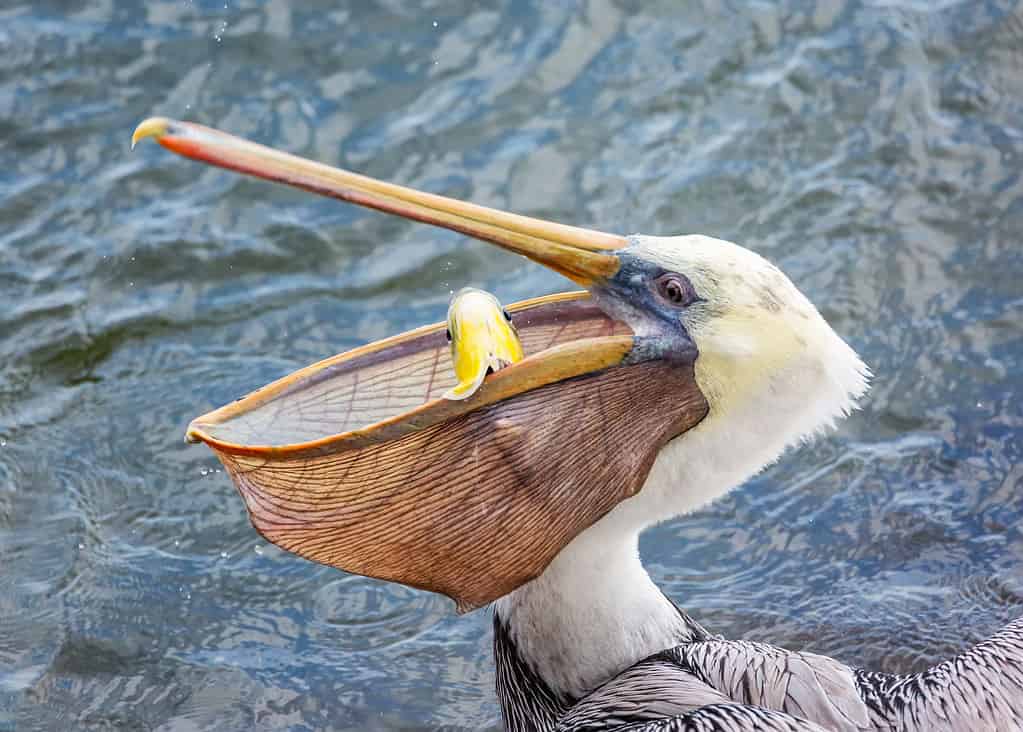
A pelican uses its bill to scoop up fish along with water into its mouth.
©iStock.com/
8 Types of Pelicans
American White Pelican
The American white pelican is a majestic bird that can be found across North America, from southern Canada to the Gulf of Mexico. This species of the pelican is known for its striking white plumage and large size, with a wingspan that can reach up to 9 feet in length. They are primarily found near bodies of water such as lakes, rivers, and wetlands, where they feed on fish by plunging their bills into the water and scooping up their prey. Despite being widespread throughout North America, this species has faced threats in recent years due to habitat loss and pollution. Conservation efforts have been put in place to protect these beautiful birds and ensure their survival for generations to come.
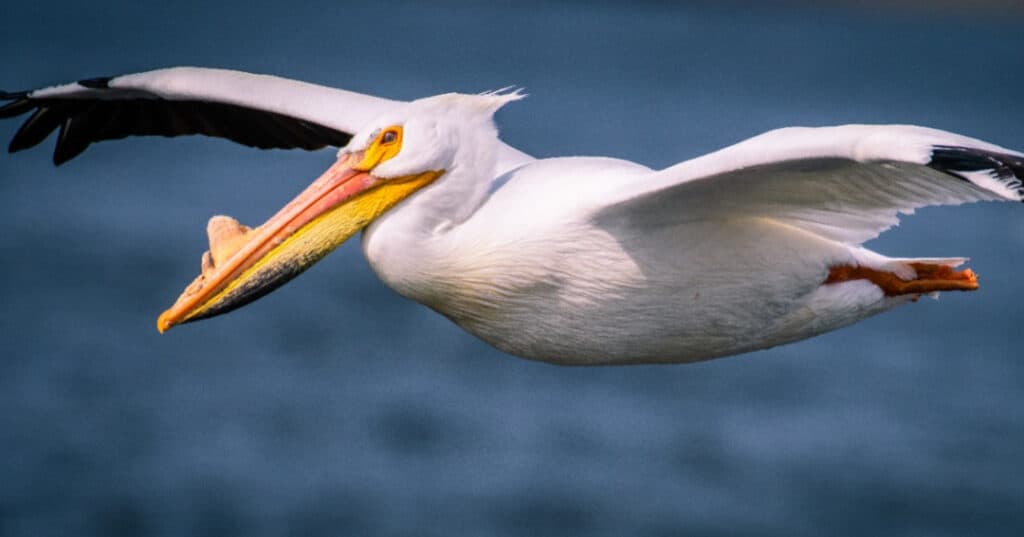
The American white pelican has a wingspan that can reach up to 9 feet in length.
©Jerek Vaughn/Shutterstock.com
Brown Pelican
The brown pelican (Pelecanus occidentalis) is a species of pelican that can be found in coastal areas throughout the Americas, from the southeastern United States to northern South America. They are commonly seen in estuaries, mangroves, bays, and lagoons, as well as along sandy beaches and rocky shorelines. The range of this bird also includes several Caribbean islands and parts of Central America.
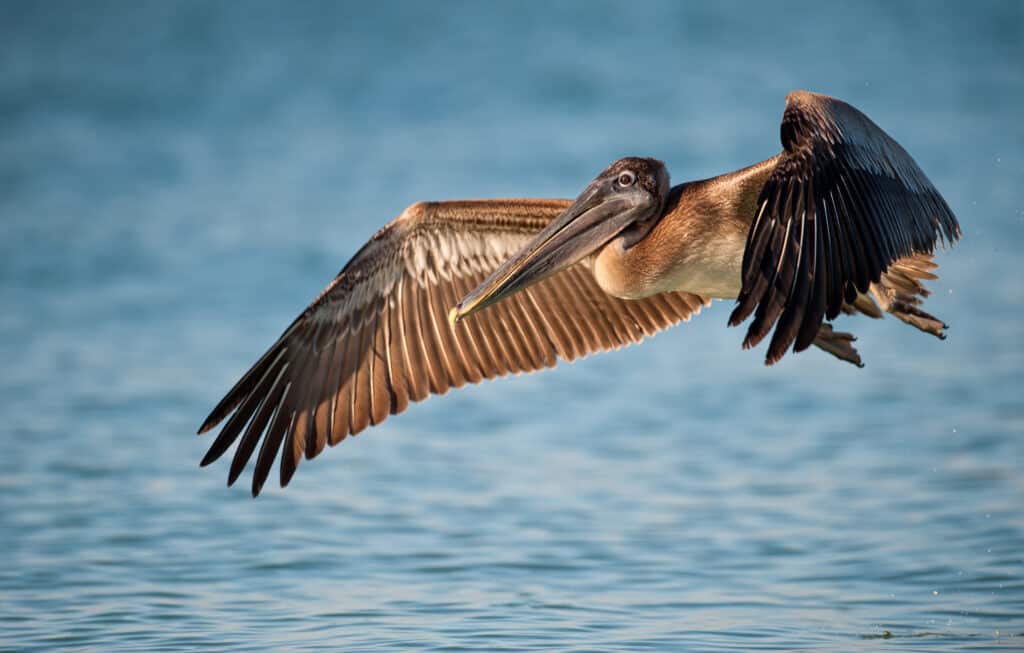
Brown pelicans can be found in coastal areas throughout the Americas commonly seen in in estuaries, mangroves, bays, lagoons and shorelines.
©Nagel Photography/Shutterstock.com
Peruvian Pelican
The Peruvian pelican (Pelecanus thagus) is a large and distinctive species of pelican that can be found along the west coast of South America, from Ecuador to Chile. These birds have a unique appearance with their white plumage, black primary feathers, and pink facial skin. They are known for their impressive wingspan, which can reach up to 8 feet in length. The Peruvian pelican primarily feeds on small fish, such as anchovies and sardines, using its large throat pouch to scoop them up from the water’s surface. Despite being a common sight along the coastlines of Peru, these birds face threats from habitat loss due to human activities such as fishing and pollution.
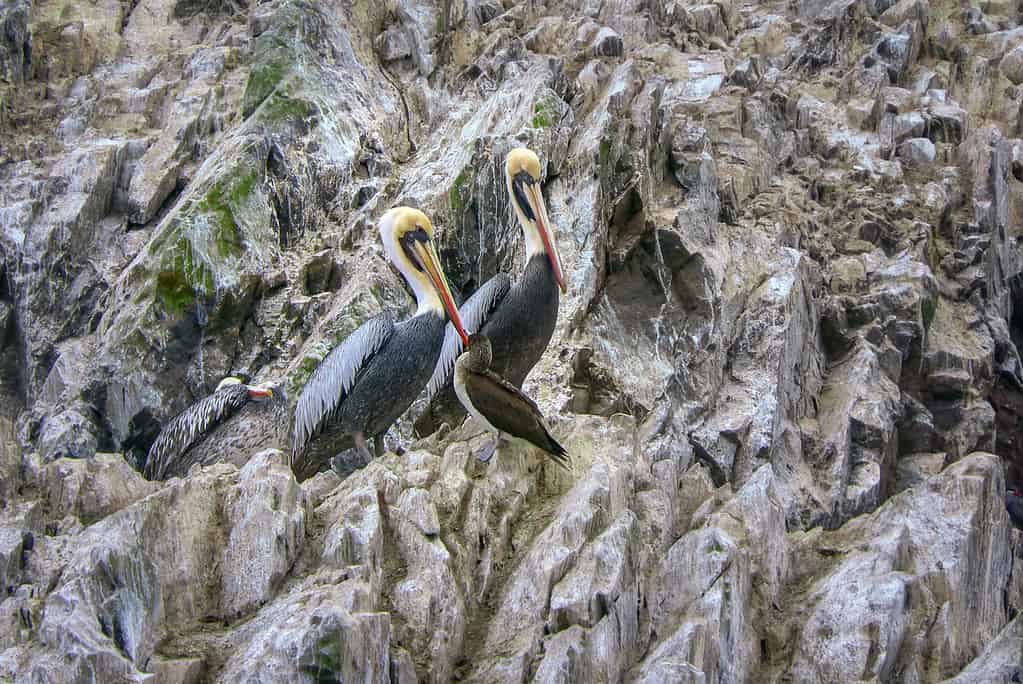
Peruvian pelicans have white plumage, black primary feathers, and pink facial skin with a wingspan that can reach up to 8 feet.
©iStock.com/
Great White Pelican
The great white pelican is a large bird that can be found in various parts of the world, including Africa, Asia, and Europe. It is known for its distinctive appearance with a white body and black wings. This species typically prefers freshwater habitats such as lakes or rivers but can also be found near coastal areas. They are social birds and often gather in colonies during the breeding season. The great white pelican feeds on fish by dipping their bills into the water to scoop them up. Conservation efforts have helped stabilize populations in some regions where they were once endangered due to habitat loss and hunting pressures.
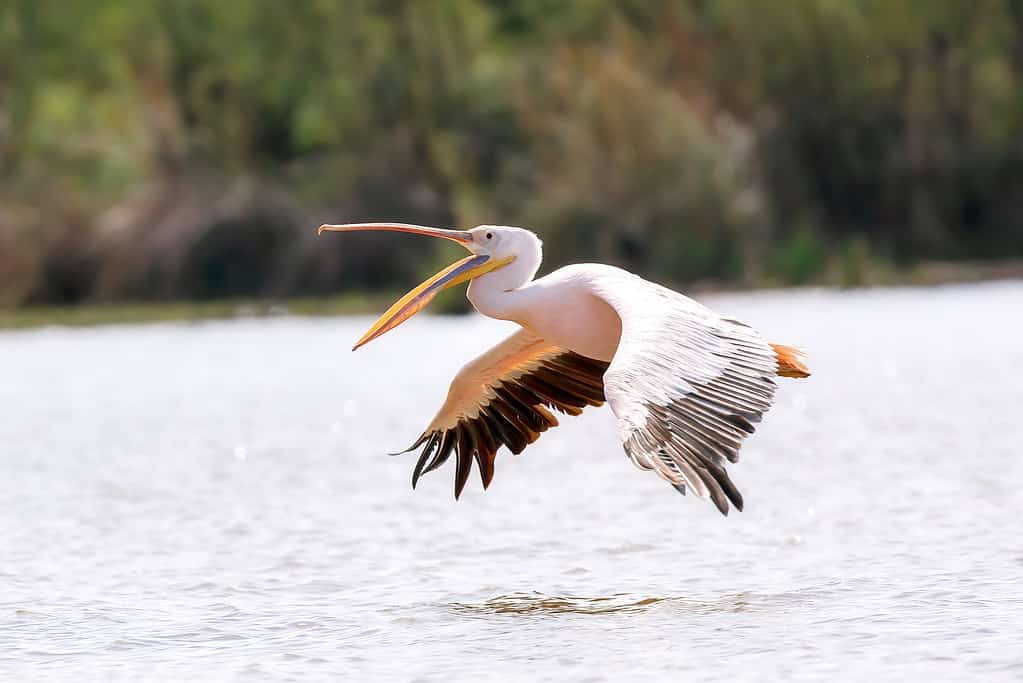
The great white pelican has a white body with black wings.
©iStock.com/
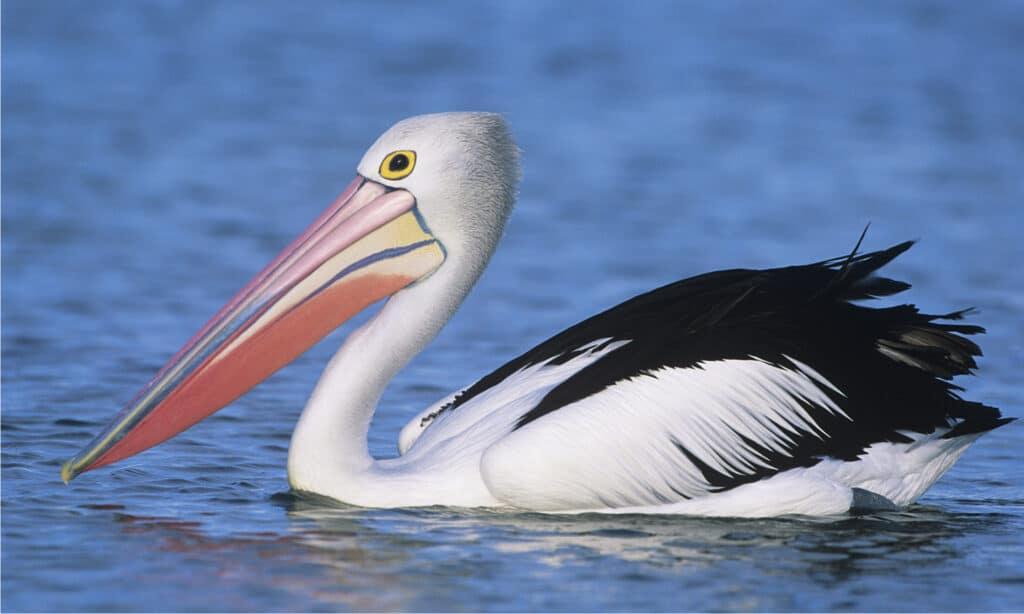
The Australian pelican is an at-risk species due to habitat loss.
©sirtravelalot/Shutterstock.com
The Australian pelican, also known as Pelecanus conspicillatus, is a large water bird that can be found in various habitats throughout Australia, including coastal areas, estuaries, and inland lakes. They are also found in New Guinea, New Zealand, Bismarck, Fiji, and the Solomon Islands. These birds have a distinctive appearance with their long bills and stretchy throat pouches, which they use to scoop up fish from the water. They are social creatures and often gather in groups or colonies during the breeding season. The Australian pelican is one of the largest pelicans in the world, with males generally being larger than females. Despite being widespread across Australia, they are considered to be an at-risk species due to habitat loss and degradation caused by human activity.
Pink-Backed Pelican
The pink-backed pelican is a species of pelican found in parts of Africa, including the Democratic Republic of Congo, Uganda, and Tanzania. They are typically found near large bodies of water such as lakes or rivers. These birds can reach up to 5 feet in length and have a wingspan that can exceed 9 feet. Their distinguishing feature is the pink-colored feathers on their back during the breeding season. Unlike other pelicans, they primarily feed on fish that swim close to the surface rather than diving for them. The pink-backed pelican is considered a threatened species due to habitat loss and hunting for their meat and eggs.

Dalmatian Pelican
The dalmatian pelican is the biggest pelican in the world, with a giant wingspan of up to 11 feet. They are native to Europe and Asia and can be found in freshwater lakes, rivers, and deltas. These pelicans have distinctive white feathers on their heads and a bright yellow pouch under their bills. They primarily feed on fish but will also eat amphibians and crustaceans. Due to habitat loss and hunting, the Dalmatian Pelican is considered endangered in some areas. Conservation efforts are underway to protect these majestic birds for future generations to enjoy.
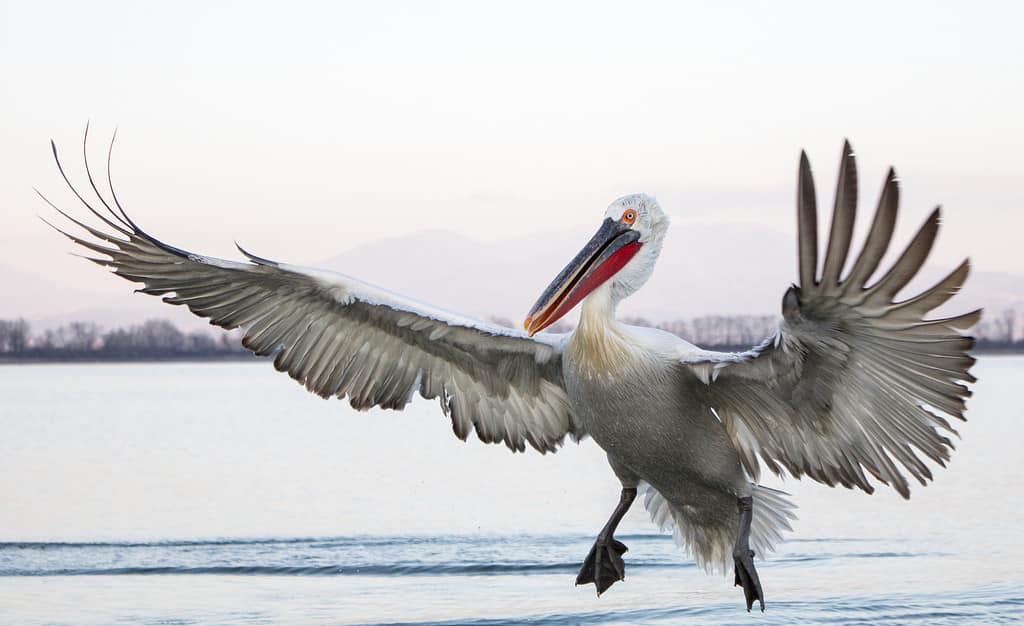
The dalmatian pelican has a wingspan of up to 11 feet making it the largest pelican in the world.
©
Spot-Billed Pelican
The spot-billed pelican is a species of pelican that can be found in South and Southeast Asia. They are medium-sized birds, measuring around 5 feet in length, with a wingspan of 8.2 feet. These pelicans have distinctive spotted bills, which give them their name. They primarily feed on fish and other aquatic creatures and can often be seen diving into the water to catch their prey. Unfortunately, the spot-billed pelican is listed as Near Threatened due to habitat loss and hunting for food and feathers. Conservation efforts are being made to protect this beautiful bird species from further decline.
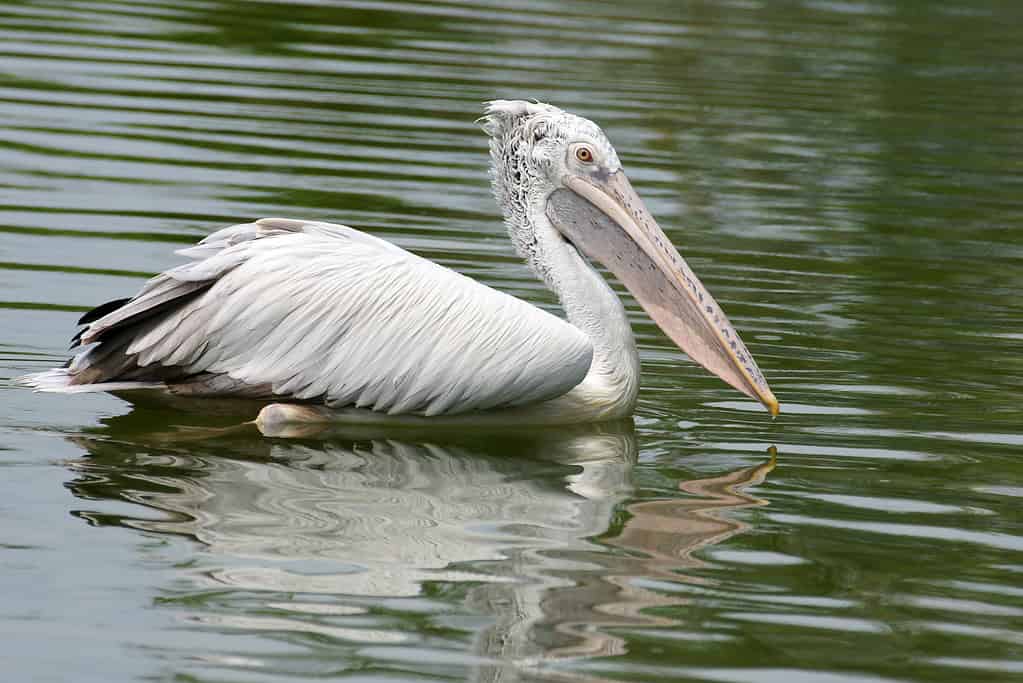
The spot-billed pelican gets its name from their distinctive spotted bills.
©iStock.com/dangdumrong
The photo featured at the top of this post is © iStock.com/Безгодов
Thank you for reading! Have some feedback for us? Contact the AZ Animals editorial team.






